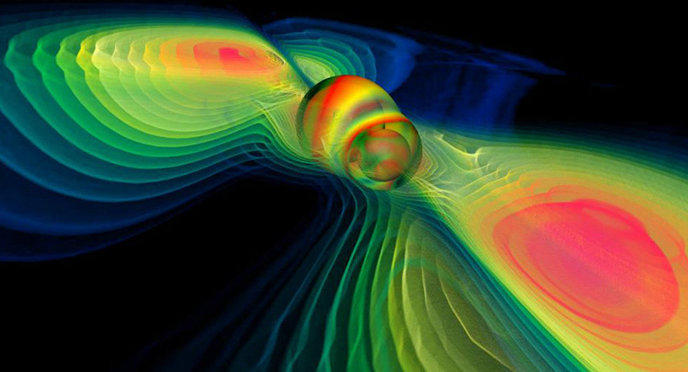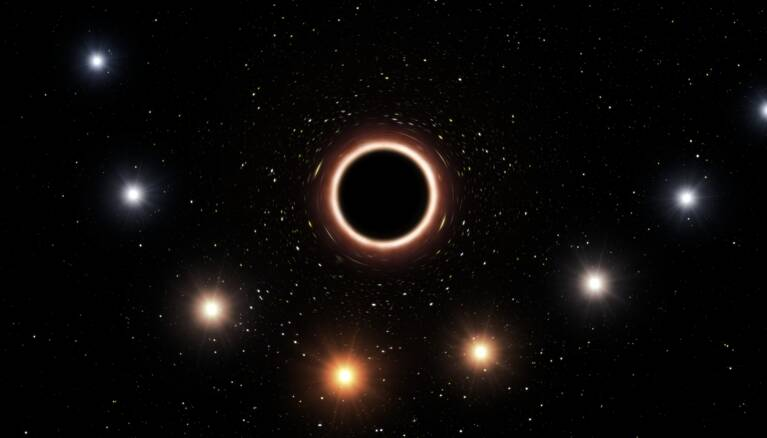Einstein was right: science "hears" gravitational waves for the first time

A scientific consortium has managed to identify minute variations using pulsars which confirms a theory of Einstein which he himself sometimes doubted: gravitational waves.
It is a major discovery in the history of astronomy: the detection of gravitational waves, a theory of Einstein which until now had never been able to be directly spotted. The team behind the investigation published on June 28, 2023 in Astronomy and Astrophysics and The Astrophysical Journal the conclusions of this scientific breakthrough, which requires quickly resuming the work of Newton and Einstein to understand how scientists were able to "hear "These waves.
A complex Einstein theory to observe
We must take up the work of Newton and Einstein. In the 17th century, Newton theorized universal gravitation: masses attract each other with variations depending on their weight and distance. The movement of objects is aligned with this gravity: the Moon, moving in one direction, is however constantly subject to gravity which attracts it towards the Earth. It therefore emits a rotation around the Earth since it is both attracted towards the Earth and moving in a different direction, placing it in a circular trajectory.
“More than 100 years after his article posing the equations of general relativity, Einstein shows that he is once again right, in a laboratory much more extreme than what he could imagine”, notes the ESO.
A black hole is an object so dense that it prevents all matter or light from escaping. It is called supermassive when its mass ranges from a few million to a few billion solar masses.
The center of our galaxy is home to one of these invisible monsters, Sagittarius A*, located 26,000 light years from Earth. Its mass is equivalent to 4 million times that of the Sun.

It is surrounded by a cluster of stars which reach dizzying speeds when they approach it.
Relying on Gravity and two other VLT instruments, the international team of astronomers took an interest in one of these stars, S2, and observed it before and after it passed closest to Sagittarius A* which took place on May 19.
The Gravity interferometer, the design of which took more than ten years, combines the light collected by four telescopes of the European VLT installed in the Atacama desert in Chile. Its resolution is 15 times greater than that of the largest optical telescopes.
It is a major discovery in the history of astronomy: the detection of gravitational waves, a theory of Einstein which until now had never been able to be directly identified. The team behind the investigation published on June 28, 2023 in Astronomy and Astrophysics and The Astrophysical Journal the conclusions of this scientific breakthrough, which requires quickly resuming the work of Newton and Einstein to understand how scientists were able to "hear "These waves.
A complex Einstein theory to observe
We must take up the work of Newton and Einstein. In the 17th century, Newton theorized universal gravitation: masses attract each other with variations depending on their weight and distance. The movement of objects is aligned with this gravity: the Moon, moving in one direction, is however constantly subject to gravity which attracts it towards the Earth. It therefore emits a rotation around the Earth since it is both attracted towards the Earth and moving in a different direction, placing it in a circular trajectory.
The precision achieved was 50 microseconds of angle, "the angle at which a tennis ball placed on the Moon would be seen from the Earth", according to the French CNRS.

Thanks to this precision, the movement of S2 around Sagittarius A* could be detected almost hour by hour.
When the star passed 120 times the Earth-Sun distance from the black hole (less than 20 billion kilometers), its orbital speed reached 8,000 kilometers per second, or nearly 3% of the speed of light. Sufficiently extreme conditions for the star S2 to undergo significant effects linked to general relativity.
"According to this theory, a massive body attracts light (it bends light rays) or slows down time. It is this latter effect that leads to reddening around Sagittarius A*", explains Guy Perrin, who is an astronomer at the Paris-PSL Observatory.
"As the star approaches the black hole, it appears redder than it actually is" because there is a shift in wavelengths towards the red, due to the very strong gravitational attraction of the hole black," he added.
This is the first time that this effect has been measured directly for the intense gravitational field of a black hole.
"Our measurements are totally compatible with Einstein's theory", says Guy Perrin. On the other hand, Newton's classic theory of gravitation, also tested by astronomers, "does not fit with our measurements".
For the ESO, these results are "the culmination of 26 years of observations" carried out with its telescopes.
The Gravity consortium is led by the Max Planck Institute for Extraterrestrial Physics and notably involves the CNRS, the Paris-PSL Observatory, the University of Grenoble-Alpes, the Portuguese Center for Astrophysics CENTRA.
Source: websites

